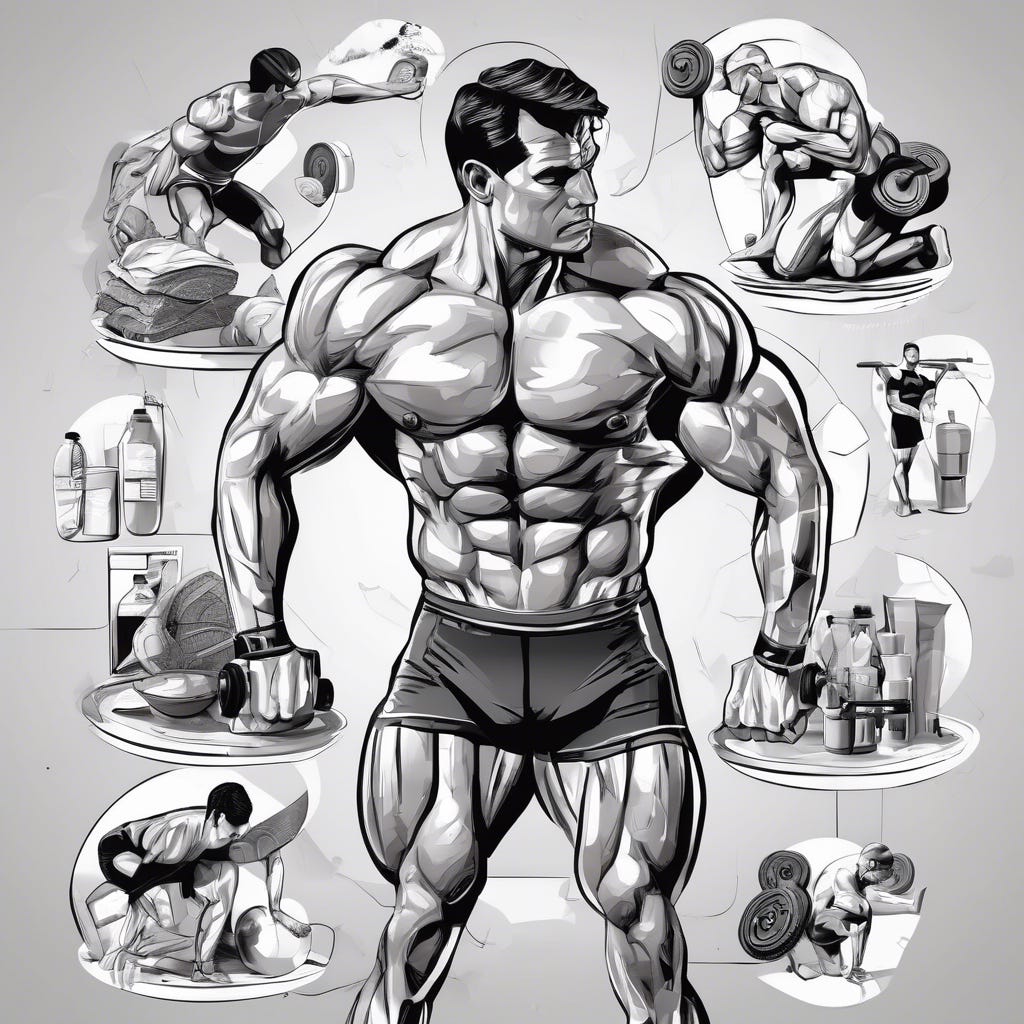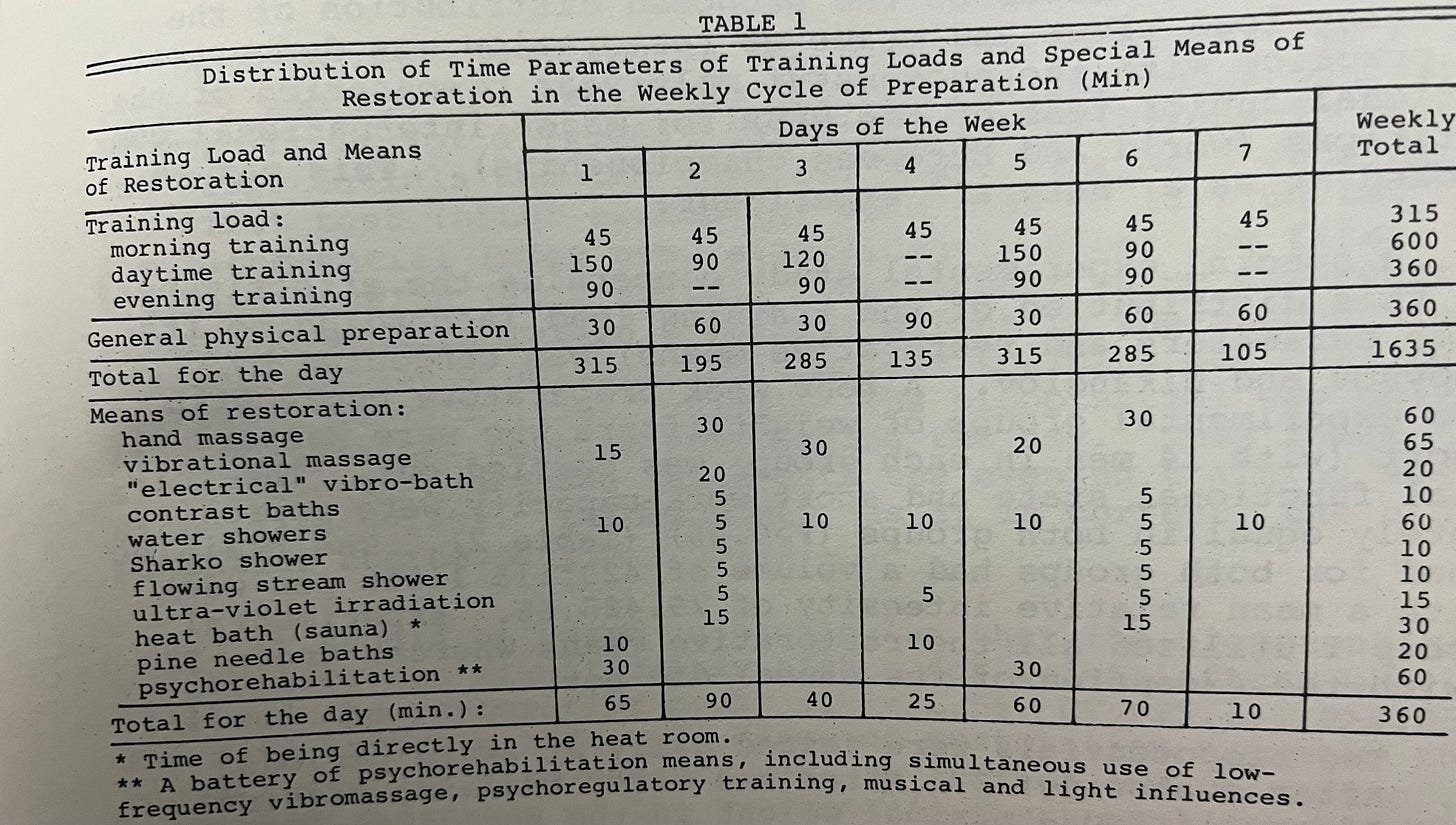Recovery Methods for Bodybuilding
Part One: Introduction
Introduction
Let's talk recovery. Finally. It's a topic that does not get nearly enough airtime from bodybuilders, who'd seemingly rather talk about trenbolone war stories and debate the merits of injecting progesterone than to get together to discuss the more effective aspects of bodybuilding interventions.
This is part one (1) of a three-part (3-part) series about recovery methods for bodybuilding, an introduction written here in this overview format. We'll hone in on some of the more popular and more effective modalities for our discussion, and note, that the two are not always integrally linked – what works versus what's popular can often be like apples to oranges!
The recovery aspects of bodybuilding, the benefits of letting the tissues adapt, and the nervous system tamp-down a bit, after hard, high effort training with heavy loads is a woefully underserved topic among bodybuilders to the extreme detriment of the sport, at its brink it would seem, that it's at the point that as we look around today, and as we move up from the level of each and every single individual who is involved in this cognitive dissonance – to the local gym culture, and rising through the ranks and across the stands and bleachers abutting the largest stages themselves – that this topic is like a hollowed-out ghost town compared to drug chats.
This disregard, we'll call it antipathy, takes root in, I believe, an overreliance on the drug lever, as well as a cultural attitude that can only kindly be described as uninformed. Or, alternatively, maybe too many guys are just training like broads – and I use that term narrowly so as to cause no offense whatsoever to the women that train like beasts out there!
In no other barbell sport – among them, weightlifting, strongman, powerlifting, and even Crossfit, no matter how much derision the latter might face for having rescuscitated what we used to call bootcamp training but successfully repackaged it for yuppies… at the end of the day every other weight lifter besides bodybuilders takes recovery very seriously... and they sure as shit use gear too, please... don't fucking make me laugh!
With the exception of weightlifting, an IOC sport, drug use is part and parcel of these other barbell sports unless you are a rare personality type, or still just a young adult afraid of the risks of anabolics – and rightfully so – who settles instead for a drug-free federation. In that case, you won't hear any derision from me!
Traditional Western Methods
These methods are those in popular use in countries like those in North America and Northwestern Europe mostly:
Active Recovery
Sessions of reduced effort, intensity, and loading, that should be interspersed to promote adaptation without anhedonia and inertia setting in.
Athletic Massage
A targeted massage tailored for bodybuilders that focuses on exhausted soft tissues, sinews, and especially, fascia, the epimysium and perimysium of muscle fibers.
Compressive Myofascial Release
Compressive myofascial release permits the bodybuilder to apply pressure on his own muscles and soft tissues using hands, foam rollers, or specialized tools to relieve tension and improve circulation. Or for a practitioner to apply it to someone else's, too, of course.
Traditional Eastern European Methods
Table 1 describes the means of restoration (recovery modalities) employed by the Soviet Weightlifting National Junior Team with respect to training loads (here, as training time [minutes]) and sums the total daily time spent on recovery. Soviet Sports Review.
Sauna
A small room designed to be heated to high temperatures, inducing sweating, which can aid in detoxification, release of β-endorphin and endogenous opioids (endorphins), glucocorticoids, and vasodilators that relax muscle, sooth pain, relax the vessels, capillaries, veins and arteries, cause muscle relaxation, and improved circulation.
Jacuzzi
A bathtub or pool featuring underwater jets that massage the body, helping to relax muscles and increase blood flow.
Steam
A room filled with moist heat generated by a steam generator promotes sweating, which can aid in relaxation, detoxification, and skin cleansing.
Contrast Showers
Alternating between hot and cold water during a shower. This method can help muscle recovery by enhancing circulation and reducing muscle inflammation.
Parasympathetic Tone and Heart-Rate Variability
These aforementioned Traditional Eastern European Methods as recovery modalities serve to increase β-endorphins and to increase adrenocorticotropic hormone (ACTH) in blood. These changes reflect a parasympathetic state. By decreasing arousal, these methods – that can be combined – cause an increased noradrenaline or norepinephine, thereby enhancing parasympathetic tone, stimulating the renin-angiotensin-aldosterone system (RAAS), and antidiuretic hormone (ADH).
Other Projects
Bolus
A Practical and Reference Guide for the Use of Human Growth Hormone and GH Secretagogues
For those interested in growth hormone and related pathways, my book, Bolus, covers the deeper science behind these anabolic mechanisms.
Contemporary Western, Ahem, Yuppie Methods
Ice Baths, Cold Plunging, and Cold Water Immersion
Immersion in cold water, typically after intense physical activity, reduces inflammation, that can be balanced to effectively promote adaptation and recovery – but this interest must be weighted against the potential for blunting hypertrophy, the muscle recovery processes.
Briefly, I will discuss two (2) distinct cold water immersion (CWI) modalities –
First – Post-training CWI, as ice baths or cold showers (≤ 10° C, or no warmer than 50° F; for durations no shorter than 2.5 min but no longer than 12 min) are a recovery modality that can improve strength and recovery (ergogenic) by increasing muscular power for the following training session or exercise bout when applied within 2 h after a resistance training bout.
Second – Pre-cooling, as ice baths or cold showers (≤ 10° C, or no warmer than 50° F; for durations no shorter than 2.5 min but no longer than 12 min) is a potentiation tactic that cannot improve strength performance but actually hinders it (ergolytic). This tactic is excellent, however, for aerobic-endurance exercise bouts (especially in warm temperatures or hot climates) because they increase total volume (# of reps performed), decrease time to exhaustion (onset of fatigue), for cyclical cardiorespiratory exercise performance (e.g., repeated running), but not for acyclical neuromusculoskeletal exercise performance (e.g., weight lifting).
An acceptable pre- or intra- session cooling tactic involves cold compresses on the head, neck, or palm before heavy exertion in hot temperatures and humid climates. Since this tactic avoid cooling the hamstrings and quadriceps and serve a localized thermoregulatory function, these are advisable during training sessions on hot and muggy summer days.
Pre-cooling, since it is ergolytic (performance-worsening), will not be discussed any further.
Example 1
For an athlete who performs heavy incline barbell bench press training Monday and a light lower body session Tuesday, his taking two 2.5 min ice baths (totally immersed, or lower body immersed) with a 2.5 min readaptation to room temperature (< 30° C or no warmer than 86° F), should improve performance for the Tuesday training session.
Considerations
However, post-training CWI as a recovery modality also presents with ergolytic (performance-worsening) effects (i.e., for hypertrophy).
Diminished hypertrophy: The acute inflammatory response to muscular work is an integral signal for stimulating hypertrophy. Because cold temperatures blunt the acute inflammatory response, the rationale from Example 1 (enhanced power for the subsequent training session) does not apply where:
1. The objective of the block/mesocycle is oriented towards increasing muscle size and strength, and/or
2. The task of subsequent session does not encompass muscle power as an adaptation (e.g., a Wednesday injury prevention/hypertrophy session; a Friday total-body session, e.g., exercise selection include a heavy squat or deadlift rather than a faster dynamic/concentric workload.
Counterexample 2
For a bodybuilder whose training phase is currently oriented towards moving up a weight class, and whose sessions include exercises for building up particular muscle groups, the use of post-training CWI is not supported, because of diminished hypertrophy that will result.
About the Author
Type-IIx is an expert on all methods used in enhanced bodybuilding and the author of Bolus: A Practical and Reference Guide for the Use of Human Growth Hormone and GH Secretagogues. His articles can be found on Meso-Rx and his coaching, consulting, and services on the Team Ampouletude website. Tune in to the Gear, Growth, and Gains Podcast on the web [www] – [telegram] – [spotify] – and everywhere podcasts stream!
Counterexample 3
For an athlete who performs a Wednesday injury prevention or hypertrophy session, post-training CWI is not supported, because of diminished hypertrophy that will result.
No effect on strength: CWI doesn't meaningfully affect the adaptations that encompass muscular strength.
CWI is useful for cognition and evokes a feeling of "getting your day started," which has benefits. CWI does reduce delayed-onset muscle soreness (DOMS. While DOMS is not a performance variable in itself, if you find DOMS uncomfortable, CWI will reduce it.
CWI can be used strategically, especially within two hours (2 h) after a strenuous training session to go into the subsequent session with more power. It does blunt hypertrophy, however, so bear that in mind.
Evidence-Based Methods
These evidence-based methods come equipped alongside more robust evidence that will be expounded upon in the next parts of this three-part series.
Active Release Techniques
Active Release Techniques (ART), often performed by better-than-half decent chiropractors who invest into a continuing education about the neuromusculoskeletal system, these techniques comprise proprioceptive neuromuscular facilitation (PNF) stretching in a way that leverages the muscle spindles and Golgi tendon organs of the muscles to effectively lengthen muscle fibers while they shorten, a similar concept to eccentric or negative loading in the gym.
Body Tempering
A method where long, steel, cylindrical pins are rolled along the body. Strange – yes. But effective, especially in terms of the acute strength and power benefit. This one's progenitor is a particular, successful NFL team's coach.
Electrostimulation
A process where electric currents are applied to muscles to cause them to contract, aiding in muscle strength, recovery, and pain relief.
Graston Technique
A practice that uses Medieval-looking torture devices that have been dulled down by the hangman before gently annihilating some soccer mom's fascia. Make sure that you have a good practitioner for this!
Ultrasound
A therapeutic method using sound waves treats injuries by promoting blood flow and reducing inflammation in the affected areas.
Voodoo Flossing
A compressive method that uses medical-grade latex rubber banding to compress a joint, muscle group, or muscle, while the bodybuilder actively moves through a range-of-motion (ROM) to cause reactive hyperemia, or an overcompensation in blood flow back into the active muscle after brief hypoxia.
Conclusion
Hopefully this brief introduction has primed you for the topics to follow. We'll simply hone in on those more effective recovery modalities, drawing on the best from traditional to contemporary, and from West to East, eventually distilling down a handful of those that serve different purposes with the most benefit, and the least amount of time and money wasted through experimentation!
About the Author
Type-IIx is an expert on all methods used in enhanced bodybuilding and the author of Bolus: A Practical and Reference Guide for the Use of Human Growth Hormone and GH Secretagogues. His articles can be found on Meso-Rx and his coaching, consulting, and services on the Team Ampouletude website. Tune in to the Gear, Growth, and Gains Podcast on the web [www] – [telegram] – [spotify] – and everywhere podcasts stream!




